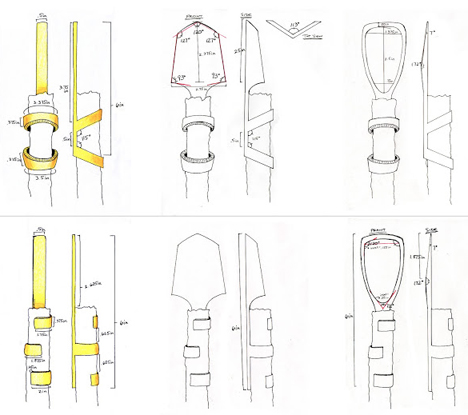
In design school these days, we've gone so far around the 'sustainability' bend that it seems like the word might have lost meaning all together. That's why whenever we see unique take on the cradle-to-cradle conversation; it's a breath of fresh air. The most recent addition to the canon of sustainable design comes from the University of Michigan'sHannah Dow, in her senior BFA thesis project cleverly entitled, Temp Tools.
I created Temp Tools aiming to stir up the conversation about the complete life cycle of objects; Thinking about where our items go once they leave our house in a garbage bag. I hope that with Temp Tools, I can get people thinking about other things they own that could be designed in a similar way as the tools, with sustainability in mind.

Hannah has been developing the tool line, consisting of a skewer to roast marshmallows or hotdogs, a spatula, and a shovel for nearly 8 months. Each tool in the line can be fitted to a stick to be used as a makeshift handle and will fully degrade in nature leaving only flower seeds in its wake. While sustainable design will never embrace the 'hey, just toss it out' mentality, maybe we can still do a little guilt-free littering with our Temp Tools.
We asked Hannah to share with us some insights into both the material exploration and product development leading to Temp Tools:
Core77: How did you develop a composite material strong enough to create a durable 'temp tool'?
Hannah Dow: The material the tools are made of is what comprised my first four months of the project. After trying to find a man-made, biodegradable, strong material that I could purchase and coming up empty-handed, I realized I needed to do my best at making whatever it was that I wasn't getting elsewhere. The composite material has is completely natural and biodegradable after use and strong and rigid during its role as a tool. If put into production the tools would be made using a 3-4 part mold seeing that the material is a kind of liquid wood mixture.


Core77: Where does the life cycle of the tool end?
Providing a fool proof method for disposal (you essentially drop the tool on the ground and forget about it), the user will get into the habit of giving back, hopefully relaying the idea that the afterlives of our objects should be something more highly considered in the world of design and consumption.

Core77: What are the temp tools constructed out of?
The composite material is constructed from a gelatin-based glue and sawdust, essentially creating a liquid wood material. The composite is completely natural and biodegradable after use, as well as strong and rigid when used. [Because the composite] houses a specific species of regional flower seeds, this product addresses the problem of invasive species and explores the relationship between consumer and product; how one can establish a connection with an object even after its use is fulfilled and it has been discarded. With these tools, people will be able to actually leave their site in better condition then when they arrived. The consumer uses the tool to thrive in and manipulate different aspects of the land and then repairs it by planting the tools and promoting the growth of a new life form.


We appreciate the 'if you cant beat them, join them' take on consumer culture and her killer process sketches (a lesson for all you ID students out there). Hannah will be graduating from the University of Michigan in May and we wish her the best as she joins the design workforce.

No hay comentarios:
Publicar un comentario